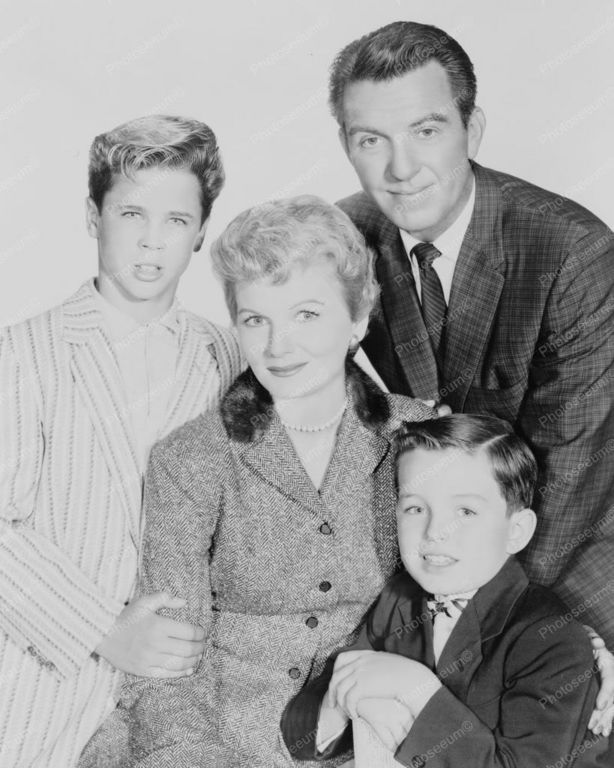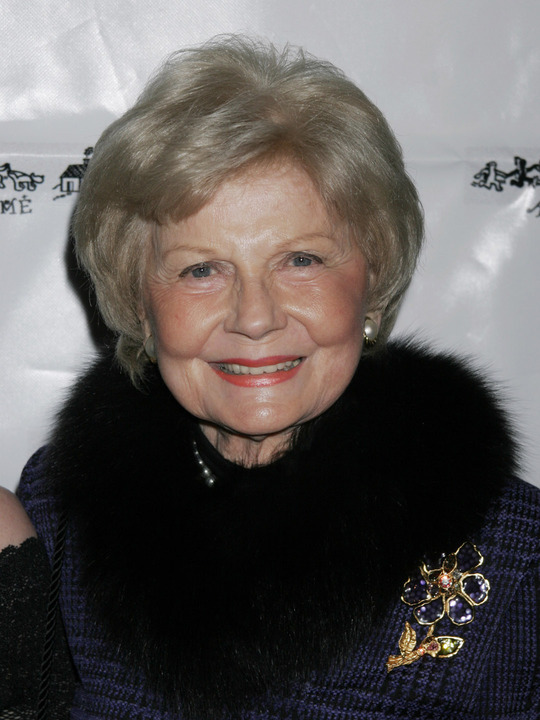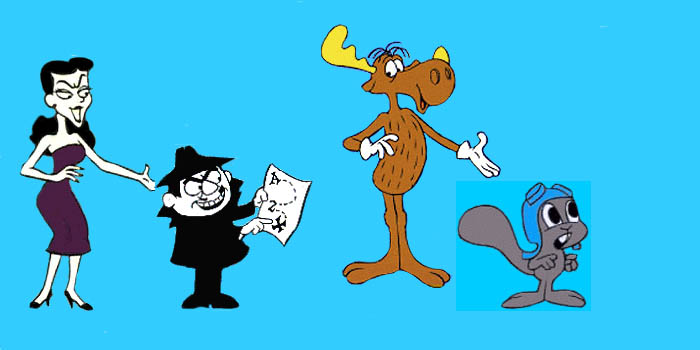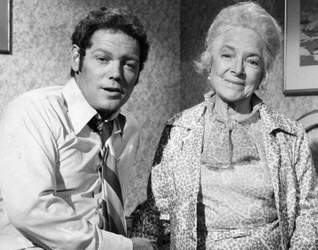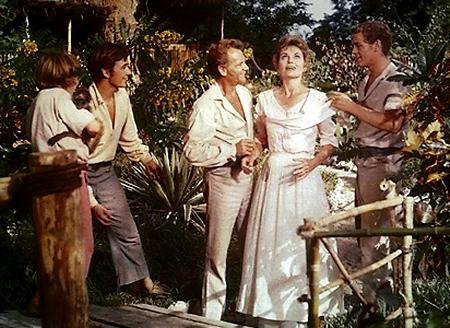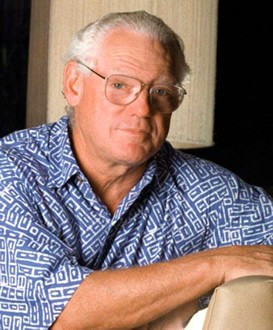Crossing Over
A Cleaver family photo (from left): Tony Dow (Wally), Barbara Billingsley (June), Hugh Beaumont (Ward); (front) Jerry Mathers (Theodore, ?The Beaver)'I Speak Jive'
BARBARA BILLINGSLEY
October 22, 1915-October 16, 2010From 1957 to 1963 actress Barbara Billingsley was the very model of the modern perfect mother in portraying June Cleaver, wife of Ward Cleaver, mother to sons Theodore ("The Beaver") and Wally on Leave It To Beaver; in 1980, returning to the big screen after a long layoff, she became even more famous to a generation that wasn't even alive when Beaver was in its first run, thanks to a less-than-one-minute scene in the Zucker Brothers' and Jim Abrahams' wacky comedy Airplane!. In a role credited only as Jive Lady, Billingsley comes to the assistance of a stewardess who cannot understand the lingo of two black men who are, like all the other passengers, falling ill from the fish dinner. "I speak jive," she explained to the stewardess, and proceeds to get down in a black dialect spoken in an untranslatable language-it was not a language, in fact—that sounded vaguely "street." As casting against type goes, Billingsley’s part was even more startling than that of Peter Graves, the film’s co-star, playing a pilot with pedophiliac predilections. Upon the release of Airplane! Billingsley had more job offers than she could handle—"it totally revived my career," she said later.
Long before Airplane!, the former Barbara Lillian Combes, a Los Angeles native who wed Glenn Billingsley in 1941 and used her married name professionally thereafter (she and Billingsley divorced in 1947), had given a perfect portrayal of the patient, sensible '50s mother of the Cleaver household in a show that reflected the mellow side of the Eisenhower era and only rarely—in some of the childrens' rebellious but harmless antics as they grew up on screen—hinted at the nonconformist self-expression of the first rock 'n' roll generation. Beaver was good, clean fun promoting a pragmatic philosophy of life in the persons of June and Ward Cleaver, who never over-reacted to crises, but rather took a more pragmatic approach and drew Aesopian morals from the half-hour mini-dramas they acted out, and communicated their feelings in warm, affectionate tones, with an occasional stern warning administered, usually by Ward (Hugh Beaumont), and often followed by a knowing smile or wink between the parents. As June, Billingsley's short blonde hair was always perfectly coiffed, she always sported waist-cinching, conservative, knee-length dresses and invariably wore high heels and pearls indoors, even when cleaning house or fixing meals. "She was the love in that family," Billingsley told the Pacific Palisades (CA) newspaper the Palisadian-Post in 2003, when she served as the grand marshall of the town's Fourth of July parade. "You bring yourself to a role like that one. The writers put some of your traits into it, too. You become the same people. I was June Cleaver." (source: http://www.palisadespost.com/obits/content.php?id=6142)
Parental guidance in Leave It To BeaverBefore she became June Cleaver, Billingsley had been a working actress for ten years mostly on screen, with some stage work. The website Legacy.com ("Where Life Stories Live On") listed 10 highlights of Billingsley's pre-Beaver career in its November 19 online issue:
1. Billingsley's big break sort of wasn't one. After a year of junior college in Los Angeles, a revue she was appearing in called Straw Hat garnered enough attention to earn a Broadway debut. Unfortunately, the production closed after only five days. Billingsley stayed in New York to work as a model.
2. MGM signed her to a contract in 1945, and the next several years would see her appearing in a host of uncredited roles playing parts like "Party Guest," "Department Store Clerk" or "Blonde With Hives." Her first credited role on the big screen was in director Cy Endfield's The Argyle Secrets (1948).
3. In 1952, she did an uncredited turn in The Bad and The Beautiful, starring Kirk Douglas and Lana Turner. Though Billingsley's role was minor, she could boast appearing opposite true Hollywood legends, and the film would go on to win five Academy Awards.
4. Billingsley also appeared in Three Guys Named Mike (1951), a film about flight attendants, opposite Jane Wyman.
5. Her biggest role on the big screen would come in The Careless Years (1957), co-starring Dean Stockwell and Natalie Trundy. The film was neither a critical nor commercial hit, and is remarkable mainly for being the directorial debut of Arthur Hiller, who would go on to make 33 major studio releases including Love Story (1970), Author! Author! (1982) and See No Evil, Hear No Evil (1989).
6. Though Leave It To Beaver ended in 1963, it appeared so frequently in syndication that Billingsley had difficulty escaping her image as the sweet 1950s matron. With trouble getting other roles, she took time out of her career to travel the world. Her second wind came when producers took comedic advantage of her wholesome persona to cast her as a jive talking passenger in the 1982 hit Airplane!.
7. After the success of Airplane!, she landed a number of comic roles on TV, including her 1982 appearance on Mork & Mindy. She would also appear on Roseanne in 1988, in 1991's Parker Lewis Can't Lose, and in My Name is Earl in 2007. Also notable was her participation in a Candid Camera sketch with fellow TV mom Isabel Sanford.
8. Billingsley had a small role in 1987's Back to The Beach. In case you're ever playing the Kevin Bacon game at home, Billingsley appeared in this film with David Bowe, who was in A Few Good Men (1992) with Kevin Bacon, giving Billingsley a Bacon number of 2.
9. Her longest recurring TV role outside of Beaver was as the voice of Nanny in Jim Henson's Muppet Babies, where she contributed to 17 episodes from 1984-1991.
10. Her final appearance was in a 2009 episode of The Office.
courtesy Legacy.com ("Where Life Stories Live On")
Barbara Billingsley: 'I was June Cleaver.'Following her divorce from Glenn Billingsley, Barbara married Roy Kellino and after his death in 1956 she married Dr. William Mortensen. They remained married until he died in 1981.
She is survived by her sons, Drew Billingsley of Granada Hills, Glenn Billingsley, Jr. (wife Karen) of Philips Ranch, stepson William Mortensen Jr. (wife Nancy) of Pacific Palisades, 16 grandchildren and 23 great-grandchildren.
"Our mom was truly the best mom,' Glenn Billingsley told the Palisadian-Post. "She was every bit as nurturing, classy and lovely as June Cleaver, and we were so proud to share her with the world."
Barbara Billingsley on Speaking Jive
'We Knew What They Wanted—They Wanted Jive As A Language'—The making of the 'jive talk' scene in Airplane!
'I Speak Jive'—Airplane! (1980)***
'Fan Mail From Some Flounder?'
ALEX ANDERSON
September 5, 1920-October 22, 2010He did not write the wacky but culturally savvy dialogue that has inspired The Simpsons, South Park and Family Guy et al., but Alex Anderson created the vehicles for expressing the multitude of cultural and literary references dropped seemingly at random and seamlessly into the near-surreal doings of various characters populating the fictional town he also created, Frostbite Falls. As John Province of the online cartoon arts website Hogan's Alley put it: “Like the Three Stooges, Elvis and I Love Lucy, the Rocky and Bullwinkle cartoons of the early 1960s have enjoyed perpetual rediscovery during the decades since their initial broadcast. As animated cousin to Mad, Rocky and Bullwinkle's paper-thin plotlines and very limited animation were almost incidental to the nonstop inside jokes, painful puns, shameless wordplay and silly satire, all masterfully delivered by the finest voice talent ever assembled.”
Anderson, who created Rocky the flying squirrel, the starstruck French-Canadian Bullwinkle Moose (who seemed incapable of responding to news of viewer letters with anything but, "Fan mail from some flounder?"), Dudley Do-Right, and the inept Russian spy team of Boris Badenov and Natasha Fatale, died of complications from Alzheimer's Disaese on October 20 at a nursing home in Carmel, CA. He was 90. All of Anderson's characters were parodies of real-life movie stars (save for Rocky, inspired by Mighty Mouse and given the middle initial J. in honor of the show’s other abiding genius, producer Jay Ward) and Bullwinkle (who, come to think of it, has some of Lucy Ricardo's zaniness in him). Dudley Do-Right does not exist without Nelson Eddy's Royal Canadian Mounted Police character in 1936's Rose Marie; Badenov is said to be based on the Armenian character actor Akim Tamiroff and Natasha on the dour Ninotchka made famous by Greta Garbo, and their boss, known only as Fearless Leader, is a takeoff on Conrad Veidt's Major Heinrich Strasser in Casablanca (he had also appeared in The Cabinet of Dr. Caligari), although Anderson told John Province of Hogan's Alley that the spies were inspired by Charles Addams's Addams Family characters.
Anderson was born on September 5, 1920 in Berkeley, CA. He attended UC Berkeley, and studied at the California School for Fine Arts in San Francisco and, on summer vacations, worked for his uncle, Paul Terry, on Terrytoons animated shorts. During World War II, Anderson served in the Navy as a spy, according to his wife.
After the war, Anderson was employed full-time for Terrytoons, in New Rochelle, N.Y. From the start he was fascinated by the possibilities TV offered for animated shows. "I began to think there was a way to do comic strips for television with just enough movement to sustain interest and having a narrator tell the story," he said. "You use a narrator so the characters don't have to act everything out." In 1948 he created Crusader Rabbit, the first cartoon series made for TV. Terrytoons, however, had been warned by 20th Century Fox that its contract would be cancelled if it got involved in television. "They clearly saw TV as a threat," Anderson told one interviewer. Told by his uncle he was free to take his ideas elsewhere, Anderson did so—right back to Berkeley, where he reunited with a friend from childhood, J Troplong Ward, or Jay Ward, then working in real estate. Sold on the Crusader Rabbit concept, Ward threw in with Anderson. Working out of a studio apartment and a duplex garage, the team created 195 episodes of Crusader Rabbit, which first aired on NBC and then in syndication. Anderson directed and supervised the scripts and primitive animation ("the show was essentially storyboards with bare-minimum movement," noted TIME's Richard Corliss).
Crusader Rabbit, Episode 1When NBC passed on renewing the Crusader Rabbit contract, Ward returned to real estate. Anderson went into advertising, but did not give up on an idea he had gestating on the drawing board. "We had called it The Comic Strips of Television, and the concept was to have a program of three or four segments, just as the later show had a potpourri of different segments," he is quoted in the Corliss piece. "In 1948, I had developed Bullwinkle and Rocky and other characters. Jay later took credit, but he didn't do it. My concept was to have a larger group of animals than just Bullwinkle and Rocky producing a television program from Frostbite Falls that would parody shows that were on television at the time."
Anderson, though, was never in creative control of Rocky and Bullwinkle, explaining to one interviewer that he had no interest in moving to Los Angeles and so chose to stay out of production. NCB would not make a deal without Anderson's involvement, "so I agreed to act as a creative consultant and to review scripts and make suggestions." Consequently, Alex Anderson disappeared as one of the key creators of Rocky and Bullwinkle, as Jay Ward (producer) and Bill Scott (writer) were given, or took, credit for the series. Even Anderson points to Scott, not himself, as having the greatest impact on the show, telling John Province, "It wasn't until later, when Bill Scott came along and went into production, that…the show took on a totally different aspect, and I certainly credit Bill for taking Rocky and Bullwinkle into a new genre."
Bullwinkle as Mr. Know-It-All: How To Cook a Turkey’s GooseAnderson sued Jay Ward Productions over copyright matters, after learning Ward had copyrighted the Rocky characters in his name only. The suit was settled in 1996, and Anderson was legally recognized as the creator of the beloved Frostbite Falls populace. Anderson spent most of his career in advertising, creating slogans for the likes of Skippy Peanut Butter and Smucker's. He lived in Carmel, CA, and is survived by two sons, six grandchildren and four great-grandchildren.
Rocky and Bullwinkle, closing scene of final episode, 1963/64 season
***
‘Book him, Danno!’
JAMES MACARTHUR
December 8, 1937-October 26, 2010
It was the moment a huge, rapt TV audience awaited every week, from 1968 to 1980. After the detectives of the Hawaii police department had spent the better part of an hour defusing bombs, foiling stings, upending the best-laid plans of master criminals and then clocking and cuffing them, the tough as nails, strict law-and-order constructionist chief of detectives, Steve McGarrett, in a tight-lipped voice laden with disdain and contempt for the evil-doers, ordered his right-hand man Danny Williams to apply the coup de grace: “Book him, Danno!”
McGarrett’s sign-off became a pop culture catchphrase, and it was revived on October 26, when it figuratively rang out across the Internet upon the news of the death of James MacArthur, the ever-resourceful “Danno.” MacArthur died in Florida of natural causes, according to his agent, Richard Lewis.
In a career that spanned four decades, MacArthur made his lasting mark in pop culture and TV history as Detective Danny Williams. The role became his when test audiences did not react well to the actor (long since forgoteen) who was originally cast in the Williams role. MacArthur did not, however, see the series out through its entire run. Claiming to be bored, he left the show prior to the start of its final season. “The stories became more bland and predictable and presented less and less challenge to me as an actor,” he wrote on his website http://www.jamesmacarthur.com/, where a note from September indicates the actor had agreed to appear in an upcoming episode of the new Hawaii Five-O on CBS. An unsuccessful 1997 attempt to revive Hawaii Five-O, with Gary Busey replacing an ill Jack Lord in the McGarrett role, featured MacArthur reprising his Danny Williams role, but not as McGarrett’s sidekick: Danno’s fortunes had risen considerably and he was now Governor Danny Williams. The pilot has never aired. The original show remains one of the longest running crime series in TV history, with 278 episodes, all shot on location in Hawaii, a TV first.
‘Book me, Danno’: McGarrett gives an order in ‘The Bark and The Bite,’ Season 11MacArthur was the last surviving original Hawaii Five-O cast member. Jack Lord died in 1998; Kam Fong (Chin Ho Kelly) died in 2002; and Gilbert Lani Kauhi (screen name of Zulu, portraying the character Kono Kalakaua) died in 2004.
MacArthur, born Dec. 8, 1937, in Los Angeles, seemed destined to become an actor. As an infant he was adopted by playwright Charles MacArthur and Helen Hayes, the legendary stage and screen actress often referred to as "First Lady of the American Theatre." Silent film star Lillian Gish was his godmother.
"They did teach me a lot about the theatre just through my life with them," he said of his parents in a 1957 interview in Teen Life magazine. "They never pushed me in any direction. Any major decision has always been my own to make."
In “The Making of MacArthur,” a 1957 interview with Howard Eisenberg in Motion Picture magazine, MacArthur related a story of how his mother had helped him gain the proper perspective when others claimed she opened all the professional doors for her son:
James MacArthur, Helen HayesNot long ago, his mother clipped a magazine article and read it to her son. It was the old story, the untrue story, of how she had gotten him started in show busines —and how, without her, he wouldn’t have gotten his first plum part.
Said Jim, “It’ll be all right.”
“The only way to lick it,” she said, “is to find within yourself the strength to say, ‘I am me. What I do has no relationship to my parents.’ Within yourself you make some kind of secret pact, a pact that says, ‘I am James MacArthur—not the son of so-and-so and so-and-so. I am me!”
In the same 1957 interview, Don McCook, the athletic director at Solebury Prep School in Nyack, NY, where MacArthur was a three-sport star athlete, said MacArthur gave no clue as to his parents’ fame and celebrity. “The first few years he was here, I didn’t even know what his parents did. I remember his father showed me some kind of railroad pass once. Said nothing about the plays and movies he’d written, or the fact he’d won a Pulitzer prize. I had the vague impression that Charles MacArthur was an engineer of some kind. And his mother—I didn?t find out her name was Helen Hayes until she came up to school to do a benefit show.”
McGarrett puts out an APB on two fish in Hawaii Five-O’s Season 1 episode, ‘Pray Love Remember, Pray Love Remember’At Solebury Prep, MacArthur was a rebellious kid who cut up in class, smoked cigarettes (strictly forbidden) on campus, arrived late for meals and generally made a nuisance of himself, to the point where he was on the fast track to expulsion. After a heart to heart talk with is parents, MacArthur became a model of civility and discipline, focusing all his energies on sports, studies and the stage.
From Motion Picture, 1957:
In football, he lined up against opposing guards who shook the scales at 220. Jim, a tough 135 pounds, was soon known as the Little Gibraltar of the Solebury line.
In baseball, he was known as a clutch hitter—the right guy to have at bat when men were on bases.
In basketball, his ball stealing and his steady shooting eye earned him the team captaincy.
Sports director Don McCook recalls, “Jim never set any great scoring records, but that’s unimportant. What really counts in the formative years is the proper blending of the three he’s—what he thinks he is, what others think he is and what he really is. It seems to me that the ‘he’ Jim turned out to be is the kind of young man any parent would be proud of.”
MacArthur (right) in Disney’s Swiss Family RobinsonIn 1957 he was accepted at Harvard, but dropped out after his sophomore year when his acting career began heating up. His breakout role was in the 1957 Climax! television series production of "The Young Stranger," in which he starred as the 17-year-old son of a movie executive who has a run-in with the law. MacArthur appeared in the Walt Disney movies Kidnapped, Third Man on the Mountain, Swiss Family Robinson and The Light in the Forest. Prior to being cast in Hawaii Five-O, he appeared in some of the most popular western, mystery and detective shows of his time: General Electric Theatre, Westinghouse/Desilu Playhouse, Burke’s Law, Alfred Hitchcock Presents, Gunsmoke, The Virginian, The Dick Powell Show, The Untouchables, Bonanza, Death Valley Days, Combat! and others. As a stage actor he won the 1961 Theatre World Award for best new actor for his performance in Invitation To a March.
MacArthur said that one of his favorite Hawaii Five-O episodes was a 1975 segment called "Retire in Sunny Hawaii Forever" because it marked one of the rare times that he worked on screen with his mother. Hayes played Danno's Aunt Clara, who visits Hawaii and helps the detectives solve a murder.
Asked by the Hawaii Star Bulletin newspaper in 2003 about his fondest memories of working on Hawaii Five-O, MacArthur replied: "Living in Hawaii."
MacArthur is survived by his wife of more than 25 years, Helen Beth Duntz, four children and seven grandchildren. His first two marriages—to the actress Joyce Bulifant, from 1958 to 1967, and to the actress Melody Patterson, from 1970 to 1975—ended in divorce.
MacArthur’s website home page opens with the following memoriam:
James Gordon MacArthur (8 December 1937-28 October 2010)
A few years ago, when Jim lost a dear friend, he took comfort in the below poem. We here at the site offer it to his family, his friends, his co-workers, his fans, and all who knew him and loved him, in the hope that we can all take a little comfort in it too.
Death is nothing at all
I have only slipped away into the next room
I am I and you are you
Whatever we were to each other
That we are still
Call me by my old familiar name
Speak to me in the easy way you always used
Put no difference into your tone
Wear no forced air of solemnity or sorrow
Laugh as we always laughed
At the little jokes we always enjoyed together
Play, smile, think of me, pray for me
Let my name be ever the household word that it always was
Let it be spoken without effort
Without the ghost of a shadow in it
Life means all that it ever meant
It is the same as it ever was
There is absolute unbroken continuity
What is death but a negligible accident?
Why should I be out of mind
Because I am out of sight?
I am waiting for you for an interval
Somewhere very near
Just around the corner
All is well.
Nothing is past; nothing is lost
One brief moment and all will be as it was before
How we shall laugh at the trouble of parting when we meet again!Canon Henry Scott-Holland, 1847-1918, Canon of St Paul's Cathedral
Founder/Publisher/Editor: David McGee
Contributing Editors: Billy Altman, Laura Fissinger, Christopher Hill, Derk Richardson
Logo Design: John Mendelsohn (www.johnmendelsohn.com)
Website Design: Kieran McGee (www.kieranmcgee.com)
Staff Photographers: Audrey Harrod (Louisville, KY; www.flickr.com/audreyharrod), Alicia Zappier (New York)
E-mail: thebluegrassspecial@gmail.com
Mailing Address: David McGee, 201 W. 85 St.—5B, New York, NY 10024


